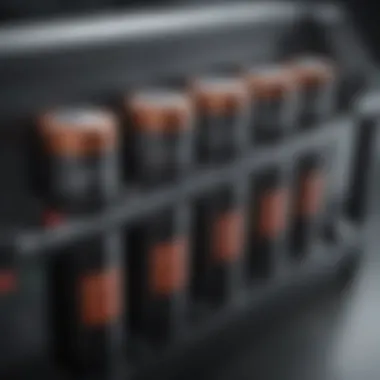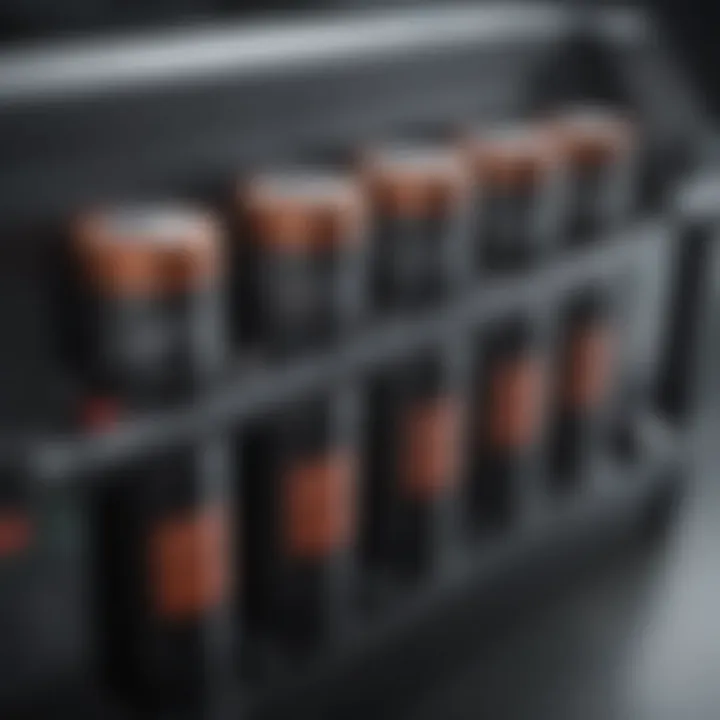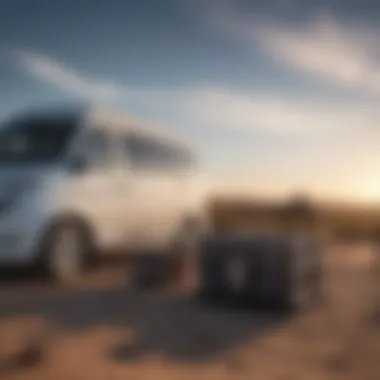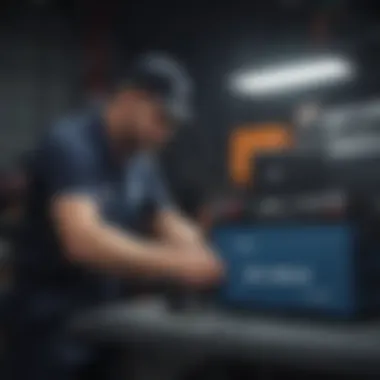Understanding Deep Cycle Batteries for Campers


Intro
When embarking on a camping adventure, the right gear can make all the difference between a trip filled with joy or one fraught with inconveniences. Among the array of equipment campers rely on, deep cycle batteries stand out as an essential component. These batteries not only power basic necessities like lights and coolers but also can fuel a sense of independence and comfort in the great outdoors.
Deep cycle batteries are designed to provide sustained energy over longer periods. This is unlike regular car batteries, which deliver quick bursts of power to start engines. The ability to discharge energy deeply and then recharge makes these batteries particularly suited for recreational use. With various types and specifications available, understanding deep cycle batteries becomes crucial for campers seeking reliability and performance on their adventures.
In this article, we will discuss key points related to deep cycle batteries, including their characteristics, types, maintenance practices, and optimal usage. By unraveling the intricacies of depth of discharge, effective charging methods, and compatibility within different systems, the goal is to arm you with knowledge that is not just trivia but a toolkit for making informed decisions.
Let's dive in!
Preamble to Deep Cycle Batteries
When it comes to camping, having a reliable power source can make or break your experience. That's where deep cycle batteries come into play. These batteries are specifically designed to provide steady power over extended periods, allowing you to use your electronic devices, lights, and appliances without a hitch. Understanding deep cycle batteries is essential for anyone wanting to enhance their camping experience, as they deliver a variety of benefits, including efficiency and longevity.
Deep cycle batteries are generally categorized for their ability to be discharged repeatedly without sustaining damage. This resilience gives campers the freedom to operate devices ranging from refrigerators to high-powered lights, all while savoring the great outdoors. The importance of knowing what deep cycle batteries can do goes beyond mere convenience; it contributes to a well-prepared camping trip.
Choosing the right battery can directly impact your adventure. With various options available, understanding the specifics behind deep cycle batteries allows you to make an informed choice. Not to mention, a solid grasp on the topic can ward off unwanted surprises—like arriving at your campsite only to find your battery is inadequate for your needs.
Defining Deep Cycle Batteries
Deep cycle batteries differ significantly from regular batteries. In simplest terms, deep cycle batteries are designed to be discharged and recharged multiple times—think of them as the workhorses of the battery world. Unlike a typical car battery that delivers a quick burst of energy to start the engine, deep cycle batteries release their charge more slowly and gradually.
This protracted discharge rate provides steady power, making them ideal for applications such as RVs, boats, and off-grid solar setups. The "deep" in deep cycle comes from their ability to degenerate down to as low as 20% of their capacity and still perform effectively when recharged. Generally, this capability leads to longer battery life and improved efficiency, as long as they are maintained properly.
When considering these batteries, think of them as marathon runners rather than sprinters. Their design allows for prolonged usage rather than quick bursts, showcasing their adaptability to various needs during camping, and other adventures.
Comparing Deep Cycle and Regular Batteries
Drawing a line between deep cycle batteries and regular batteries is pivotal for understanding their specific roles. Regular automotive batteries, often known as starter batteries, are created to furnish a substantial jolt of power for a brief moment to crank the engine. Once the engine is running, the alternator takes over and provides continual power flow. This cycle means that regular batteries are not made for frequent discharges.
On the other hand, deep cycle batteries excel in delivering sustained energy output over several hours, even days, without damaging the battery. Here are a few key points of comparison:
- Discharge Depth: Regular batteries typically don't handle more than 50% depth of discharge efficiently, while deep cycle batteries can go down to 20% without issues.
- Recharge Cycles: Deep cycle batteries can withstand 300-500 recharge cycles, while regular batteries offer a limited lifespan with significantly fewer cycles.
- Primary Use: Deep cycle batteries are ideal for campers who require continuous power for appliances, while regular batteries are best for vehicles.
"Choosing the correct battery type can lead to a smoother camping experience, minimizing the chances of equipment failure."
Understanding these differences allows campers to align their power needs with the appropriate battery type, ensuring that when you're enjoying that evening campfire, you’ll have the energy to make your experience unforgettable.
Types of Deep Cycle Batteries
When it comes to equipping campers with the right power source, understanding the types of deep cycle batteries is crucial. This knowledge arms you with the ability to select a battery that not only fits your particular needs but also optimizes your camping experience. Different battery types boast unique strengths and weaknesses, making it essential to critically evaluate how they align with your power requirements, usage scenarios, and budget.
Flooded Lead Acid Batteries
Flooded lead acid batteries are perhaps the oldest type of deep cycle battery available. These batteries contain a liquid electrolyte which is a solution of sulfuric acid and water. While they require regular maintenance—such as checking and replenishing the electrolyte levels—flooded lead acid batteries can be reliable workhorses in camper setups.
Key Characteristics:
- Cost-Effective: Generally, these batteries come with a lower upfront price compared to other types.
- Durability: They perform well in various temperatures, making them suitable for a wide range of environments.
- High Discharge Rates: Flooded batteries can provide substantial power when needed, perfect for running heavy loads.
However, despite their benefits, flooded lead acid batteries have some drawbacks: they can be bulky and might off-gas hydrogen during charging, which can be a safety concern in enclosed spaces. Careful handling and ventilation are crucial when using these batteries.
Absorbent Glass Mat (AGM) Batteries
AGM batteries are somewhat of a modern marvel in battery technology. The electrolyte in AGM batteries is absorbed in glass mats, meaning they’re sealed and don’t spill, making them safer and easier to handle.
Key Characteristics:
- Maintenance-Free: One of the standout features of AGM batteries is their low maintenance; you won’t need to check electrolyte levels.
- High Vibration Resistance: Given their design, AGM batteries withstand the bumps and jolts of vehicular travel better than flooded batteries.
- Faster Charging: AGM batteries tend to charge quicker, an attractive aspect for many campers keen to maximize their time in the great outdoors.
Despite all the perks, they come with a steeper price tag. If your camping adventure involves a bit of off-roading or if you're seeking a reliable option that doesn't require fussing over maintenance, AGM batteries prove to be a solid choice.
Lithium Ion Batteries
The game has changed with lithium ion batteries, which have revolutionized how energy is harnessed for camping. Their lightweight nature combined with significant energy density makes them a popular choice among tech-savvy campers and eco-conscious individuals.


Key Characteristics:
- Long Lifespan: Lithium batteries can last over a decade if treated well, translating to a better return on investment in the long run.
- Higher Depth of Discharge: You can use more of the battery's capacity without harming its lifespan, which maximizes the available power for electronics and appliances during your trips.
- Lightweight and Compact: Their small size and reduced weight make for easy transport and installation.
That said, lithium ion batteries also come with a heftier price tag. It's imperative to assess your power needs, how long you plan to camp, and your budget before making a purchase. In many cases, investing in lithium ion can be worthwhile if you demand efficiency and longevity.
"Choosing the right deep cycle battery can improve not only the comfort of your camping experience but also increase the longevity and usability of your electronic devices."
Overall, understanding the differences between these types of deep cycle batteries helps you make an informed decision, paving the way for enjoyable camping trips that never run short of power.
Sizing Your Deep Cycle Battery
Selecting the right size for your deep cycle battery is critical to ensure it meets your power requirements during camping trips. A suitable battery not only powers appliances effectively but also contributes to the overall efficiency and longevity of your energy system. Getting the size wrong can lead to frustrations—like unnecessary recharging or, worse, being left in the dark when you need power the most.
Calculating Power Needs
When sizing your deep cycle battery, the first step is to understand your power consumption. Each device has a specific wattage requirement. To determine your needs, simply follow these steps:
- List Your Devices: Make a list of all appliances you plan to use. Common ones include lights, refrigerators, and water pumps.
- Check Wattage: For each device, check the wattage, which is often found on a sticker or in the user manual. For example, a small LED light might use around 10 Watts, while a mini fridge could consume 60 to 100 Watts.
- Calculate Daily Usage: Multiply the wattage of each device by the number of hours you plan to use it daily.
- Total Your Needs: Sum up all the Watt-hours your devices require over a day to get your total daily usage. If your total is 2000 Wh, that’s what you need to consider when selecting a battery.
- For instance, if you plan to use the fridge for 8 hours, that would be 100W (fridge) x 8 (hours) = 800 Wh (Watt-hours).
Understanding Amp Hours (Ah)
Once you have calculated your daily power consumption in Watt-hours, the next step is understanding how to convert this into Amp-hours (Ah), which is the common measure for battery capacity.
To determine the correct Ah rating: Most deep cycle batteries are either 12V or 24V systems. For instance, if you have calculated your need of 2000 Wh and chosen a 12V battery, it would look like this:
- Consider Depth of Discharge: Different batteries have various depth of discharge (DoD) ratings, which means you can use only a percentage of the total capacity without damaging them. Lithium batteries, for instance, can usually be discharged to 80-90% without issues. In contrast, lead-acid types should typically not be discharged below 50%.
- If your battery has a DoD of 50%, you might want to double your capacity requirement. So:
This capacity will ensure that you can utilize your energy without constantly stressing your battery's health.
In summary, sizing your deep cycle battery is all about calculating your needs based on appliance wattages and considering the battery's amp-hour rating alongside its depth of discharge. By keeping these elements in mind, you can effectively tailor your battery choice for your adventurous outings.
Depth of Discharge (DoD) Explained
Understanding Depth of Discharge, commonly referred to as DoD, is crucial for anyone interested in deep cycle batteries, especially in the camping context. Essentially, DoD measures how much of a battery's total capacity has been used. The greater the DoD, the more the battery is drained. As every camper knows, managing power wisely is essential to enjoying a seamless outdoor experience. Knowing how much depth you can afford to discharge will help you care for your battery's longevity and performance.
Impact on Battery Life
A fundamental rule of thumb in battery maintenance is that the more a battery is discharged, the shorter its lifespan tends to be. Deep cycle batteries are designed to be discharged deeper than standard batteries, but this doesn't mean they’re invulnerable. For instance, if you routinely discharge a flooded lead acid battery down to 50% of its capacity, you may find that it has a life span substantially reduced compared to when discharged to 30% or less.
Commonly seen patterns indicate that a DoD of around 50% is a sweet spot for maximizing life. Here are a few key points:
- Depth matters: A higher DoD might lead to a faster decline in capacity.
- Chemistry plays a role: AGM and lithium-ion batteries can typically handle deeper discharges more efficiently than conventional lead-acid batteries.
- Temperature influence: Extreme heat or cold can further affect how DoD impacts battery life; for instance, in colder weather, batteries might struggle more.
Optimal DoD for Various Battery Types
Different battery technologies have differing capacities and tolerances for Depth of Discharge. Depending on the type of deep cycle battery, determining the optimal DoD can vary significantly. Here’s how it breaks down:
- Flooded Lead Acid Batteries:
- Absorbent Glass Mat (AGM) Batteries:
- Lithium Ion Batteries:
- Optimal DoD: Generally should not exceed 50%.
- These batteries benefit from a higher level of recharge, and deeper discharges can significantly reduce their overall life expectancy.
- Optimal DoD: Can typically handle a DoD of 60%, sometimes even more.
- AGM batteries have lower internal resistance allowing for a more efficient discharge and charging process, making them a popular choice for modern campers.
- Optimal DoD: These modern marvels can often handle up to 80-90% DoD.
- Their advanced chemistry minimizes degradation, allowing campers to pull more power without the same risk of damage as other types.
When choosing a deep cycle battery, it's crucial to consult the specifications and guidance from the manufacturers. This choice not only ensures efficiency but can also prolong the life of the equipment that you've invested in, allowing for worry-free adventures amid nature.
In the world of batteries, understanding DoD is your compass, guiding you to more efficient energy usage and a rewarding camping experience.
Charging Deep Cycle Batteries
Charging deep cycle batteries is a pivotal aspect of maximizing your camper's power supply. Understanding how to properly charge these batteries is not just beneficial; it's essential for ensuring longevity and peak performance. The driving force behind why charging methods matter comes down to efficiency, safety, and optimal usage of the battery.


When you're out in the wild, every bit of power counts. Efficient charging systems enhance the life of your battery, ensuring that it doesn’t fall flat during crucial moments like powering your fridge or lights at night. Furthermore, incorrect charging practices can lead to overheating or even battery failure, which contributes to untimely replacements and extra costs.
Available Charging Methods
Charging methods can significantly impact the performance and lifespan of deep cycle batteries. Each method has its pros and cons, depending on the situation and equipment used by the camper. Here’s a brief overview of the most common charging methods:
- Alternator Charging: This method uses your vehicle's alternator to recharge the battery while driving. While convenient, be cautious, as prolonged usage might not fully charge the deep cycle battery.
- Solar Panel Systems: Utilizing sunlight, solar panels provide a sustainable and eco-friendly way to charge your battery. This method is especially valuable for off-grid camping where access to traditional power sources is limited.
- AC Charger: Plugging into a standard wall outlet with a smart charger can be an effective method to charge your battery at home or at a campground with electrical hook-ups. This option typically offers faster charging but can be less Eco-friendly if the electricity source isn’t renewable.
- Battery to Battery Charging: This is suitable when you have multiple batteries. By connecting a secondary battery to the primary one, you can transfer power, but ensure compatibility to avoid damage.
Each method should be chosen based on your specific needs, resources available, and the type of deep cycle battery being used. Adapting these charging solutions effectively can alleviate potential worries while you aim for the great outdoors.
Understanding Charge Cycles
The concept of charge cycles is crucial for anyone utilizing deep cycle batteries. A charge cycle is defined as a full discharge followed by a full recharge. Understanding how charge cycles work can dramatically influence how you care for your battery and how long it will last.
- Cycle Count Impact: Most deep cycle batteries have a defined cycle life, usually ranging between 300 to 1500 cycles. Understanding your battery’s cycle count is essential, as it can help you track its overall health and plan for replacements accordingly.
- Partial Discharges: Commonly, batteries do not undergo full cycles. If you discharge the battery only partially, this counts as a fraction of a full cycle. Many don’t realize that frequent partial discharges can also affect longevity, depending on the battery chemistry.
- Battery Maintenance with Cycles: Keep in mind that while regular usage can optimize your battery's function, neglecting to properly recharge or allowing the battery to sit idle for long periods may lead to sulfation in lead-acid batteries or capacity reduction in lithium-ion types.
Ultimately, being aware of the importance of each charge cycle will lead to better management of your deep cycle batteries, ensuring you’re getting the most out of your investment. Here’s a crucial takeaway:
“Intelligent charging practices paired with a deep understanding of charge cycles maximize battery efficiency and lifespan.”
Integrating Deep Cycle Batteries into Your Setup
When discussing deep cycle batteries, we can’t overlook the importance of integrating them into your camping setup. These batteries are pivotal in providing consistent power when you need it the most, so understanding how to incorporate them effectively can make or break your experience while out in the wilderness.
Having the right battery setup allows campers to enjoy the comforts of modern life without the constant worry of running out of power. This aspect becomes especially significant when running multiple devices like refrigerators, lights, and other appliances. A well-integrated system can ensure that you won't be left high and dry, or in this case, without juice!
Compatibility with Solar Systems
Solar energy is a great friend to deep cycle batteries. If you're planning to power your rig with the sun, compatibility becomes a necessary consideration. Using deep cycle batteries with solar panels provides you a sustainable and renewable source of energy. It can be as simple as connecting your battery to a solar charge controller, which regulates the voltage coming from the panels into the battery itself.
- Consider Size and Capacity: It's essential to match the size of your solar system with the capacity of your battery. Otherwise, you risk underutilizing or overworking your battery.
- Charge Controller: Look for a quality charge controller that can adapt to various situations, like cloudy weather or seasonal changes, which can easily affect power generation.
- Battery Type: Different types of deep cycle batteries, like AGM or lithium-ion, can have varying efficiencies with solar setups, so pick your poison wisely for the best results.
"Solar power and deep cycle batteries are like peanut butter and jelly—great apart, but even better together!"
Using Batteries with Inverters
Inverters are the unsung heroes of camping setups that utilize deep cycle batteries. They convert the DC power stored in your battery into AC power, which is what many of your devices run on. Ensuring a harmonious relationship between your battery and inverter will maximize your power usage while minimizing potential issues.
- Inverter Size: Match your inverter's size with your power needs. Too small? You might face overload. Too big? You're wasting resources.
- Inverter Type: Choose between pure sine wave and modified sine wave inverters based on the devices you'll be using. High-tech gadgets often require pure sine wave, while simpler appliances can usually function with modified sine wave.
- Efficiency: Keep in mind the inverter's efficiency rating since this will impact how much energy you actually use from your batteries.
By understanding these nuances of integrating deep cycle batteries into your system, you put yourself in a much better position to enjoy your outdoor adventures. It's all about aligning the right pieces to build a cohesive and efficient power system, allowing you to focus on the sights and sounds of nature, rather than worrying about your next charge.
Maintenance of Deep Cycle Batteries
Proper maintenance of deep cycle batteries is foundational to ensuring their longevity and performance, especially for campers who rely on these power sources for their adventures. Just like you wouldn’t ignore an oil change in your vehicle, neglecting the care of your batteries can lead to underperformance, reduced capacity, and ultimately costly replacements. Regular maintenance not only ensures that your battery runs smoothly but also enhances safety during usage.
Regular Inspection and Testing
Performing routine inspections and testing is crucial for identifying any potential issues before they escalate. Here are some key elements to consider:
- Physical Inspection: Check for any signs of corrosion on terminals. Corrosion can cause poor connections, which hamper the performance and may even lead to leakage issues. Cleaning terminals with a baking soda solution helps prevent this problem.
- Check Electrolyte Levels: For flooded lead-acid batteries, ensure the electrolyte is covering the plates. If it’s low, top it up with distilled water. For AGM or lithium batteries, just verify that the reading fits within normal range.
- Voltage Measurement: Using a multimeter can help determine the battery's state of charge accurately. A fully charged deep cycle battery will generally read around 12.6 volts or more, while anything below 12.4 volts may indicate a charge is needed.
- Load Testing: This can be done using a load tester to see how the battery performs under stress. It helps in identifying weak cells that may not hold a charge properly anymore.
Performing these habits regularly can save you from dire straits during a camping trip.
Common Issues and Troubleshooting
Even with due diligence, issues may still arise from time to time. Here’s what to watch for:
- Sulfation: This occurs when a battery isn’t charged properly, causing lead sulfate crystals to form on plates. If left unchecked, it reduces capacity significantly. To combat this, ensure you are using the right charge method, tailored to your battery type.
- Overheating: If you notice your battery getting hot while charging, it could indicate a problem. Overcharging can lead to damage. Check your charging method and adjust if needed.
- Inconsistent Charge: If your battery fails to hold charge over time even after inspections, it might signal that it’s nearing the end of its life cycle. Check warranties or resort to replacement if needed.
- Battery Swelling: This can indicate severe overcharging or internal damage. Swollen batteries can be hazardous, so stop using them immediately and consult a professional for disposal or replacement.
Remember: Taking preventive steps and conducting regular maintenance not only maximizes performance but also minimizes surprises when you’re out in the great outdoors hiking or traveling.
Incorporating these measures helps keep your deep cycle batteries operating effectively, ensuring that your energy needs are met while camping. Keeping experience in mind not just enhances performance but can also save your wallet in the long run.
Safety Considerations
When it comes to deep cycle batteries, ensuring safety is crucial. These batteries power various equipment that enhances the camping experience, and any mishap can lead to serious situations—think fire hazards or equipment damage. Understanding the nuances of handling, storing, and maintaining your batteries can save you a whole lot of trouble down the road. Let’s break this down into two main parts: handling and transportation as well as preventing short circuits and overheating.


Handling and Transportation
Proper handling is like the backbone of battery safety. First things first, always treat your battery with respect. Whether you're lifting a heavy lead acid battery or a lithium option, ensure you use the right lifting techniques. Keep your back straight and steady, avoiding sudden jerks that might cause you to drop the battery.
Additionally, when transporting batteries, make sure they are secured and upright. Batteries—especially the flooded variety—can leak if not stored in the right position. Consider using a sturdy container or battery box. It's not just about convenience; it’s a matter of keeping the battery immobile during transit to avoid any sloshing of electrolyte.
Here are a few tips for safe handling and transport:
- Wear protective gear: Gloves and goggles can keep corrosive materials at bay.
- Check for loose terminals: Before moving, make sure everything is tight to avoid sparks.
- Keep the area ventilated: Batteries can emit gases; having good airflow is essential.
- Avoid extreme temperatures: Both heat and cold can have detrimental effects on battery performance and safety.
Preventing Short Circuits and Overheating
Short circuits and overheating are like the unwanted guests at a party—nobody wants them around. A short circuit can happen if a metal object comes into contact with battery terminals, creating a path for electricity that shouldn't be there. This can lead to overheating, damage, and even fire.
To dodge these scenarios, you should:
- Use terminal covers to protect against accidental contact with metal objects.
- Keep wires organized and insulated: Tidy wiring is less likely to lead to trouble.
- Monitor the battery temperature, especially while charging. If you notice the battery getting excessively hot, it’s time to step back and assess. It's all about being proactive here.
"Taking simple safety precautions when dealing with deep cycle batteries can save you from major headaches down the line."
In summary, embracing safety measures in handling and transportation, as well as being vigilant against short circuits and overheating, can significantly enhance your camping experience. After all, a safe camper is a happy camper.
Selecting the Right Brand
When it comes to purchasing deep cycle batteries, the brand you choose can significantly influence both performance and durability. Selecting a reputable company can mean the difference between a battery that powers your camping adventures smoothly and one that leaves you stranded in the middle of the wilderness. With various options available on the market, understanding the importance of brand selection becomes paramount.
A trustworthy brand often has a track record of quality and customer satisfaction. They should provide warranties, have solid customer support, and their products should generally hold a good reputation. For instance, brands like Renogy and Victron Energy are well-known for their reliability in the solar and battery industry. The offerings from these companies often showcase advancements in technology and innovations that can positively impact your camping experience.
Moreover, it’s not just about the price tag; lower-cost batteries might save money upfront but can lead to frustration with performance issues down the line. Thus, investing in a well-reviewed brand will help ensure your deep cycle batteries can withstand the rigors of the outdoors while providing the power you need.
"Investing in quality brands means investing in peace of mind for all your camping escapades."
Market Leaders and Their Offerings
Several brands dominate the market, each with unique selling points tailored to different kinds of users. Here’s a closer look at a few:
- Trojan Battery Company: Specializes in flooded lead-acid batteries. They are a go-to choice for campers who prefer the traditional technology due to its reliability and robust performance.
- Renogy: Known for their lithium batteries, Renogy offers lightweight options which have gained popularity for their longer lifespans and much improved efficiency over the years.
- Battle Born: This brand focuses solely on lithium batteries, offering premium quality with a high depth of discharge. They are ideal for serious campers who need dependable power.
Each of these companies presents a variety of products, catering to distinctive requirements ranging from budget-conscious options to high-end systems meant for extensive use. They also frequently update their offerings to include the latest innovations in battery technology, ensuring that users can enjoy better performance, efficiency, and overall user satisfaction.
User Reviews and Recommendations
User reviews can be a goldmine of information, providing insights that specs alone cannot convey. Prospective buyers should take the time to read through feedback to understand the real-world performance of the batteries they are considering.
- Positive Reviews: Many users emphasize the importance of reliability. Customers often rave about how certain brands, like Renogy, have consistently delivered on their promises. Particularly mentioning the lightweight design and the efficiency of lithium batteries, they highlight how much easier these batteries make traveling.
- Negative Experiences: On the flip side, reviews can also reveal common pitfalls. For example, users might caution against buying cheaper options that can lead to a frustrating camping experience. Issues such as reduced power output and shorter life span come up frequently in discussions, serving as a warning to others.
Platforms like Reddit and specialized battery forums are great places to gather this type of information. Here, you can find debates about which battery holds up better in varied climate conditions or advice on maintenance and care.
This guidance not only helps with brand selection but also prepares you to make an informed decision that takes into account past user experiences. By leaning into this community knowledge, you can navigate the choices with more confidence, ensuring that your next camping trip will be powered effectively.
Future Trends in Deep Cycle Battery Technology
As we navigate the evolving landscape of camping gadgets and outdoor gear, staying abreast of deep cycle battery technology is pivotal. The future of deep cycle batteries isn’t just about cranking out more power; it's about enhancing efficiency, extending lifespans, and securing better eco-conscience choices. With this knowledge, campers can optimize their setups and enjoy expeditions with fewer worries about energy sources.
Innovations in Battery Chemistry
One of the standout trends is the ongoing innovations in battery chemistry. Rather than sticking with the older lead-acid formulas, manufacturers are now fine-tuning materials for better performance. For instance, lithium iron phosphate (LiFePO4) has gained traction due to its impressive energy density and longer cycle life. This material’s inherent safety features mean it can handle higher temperatures without flipping out, reducing risks for campers in warm climates.
"New advances in battery chemistry could mean less charge time and more go time."
To put it plainly, heavier and bulkier solutions are giving way to greener and lighter options. For example, ceramic and solid-state batteries are grabbing the spotlight for their potential to offer superior performance and fit snugly into compact setups. As these technologies mature, campers may find themselves with batteries that recharge faster and discharge evenly, laying the groundwork for stress-free camping adventures.
The Shift Towards Sustainable Solutions
Now more than ever, the demand for sustainable solutions in battery technology is reshaping our outdoor experiences. Campers are more inclined to opt for products that not only meet their energy needs but also align with their environmental values. This is driving manufacturers to embrace renewable resources and eco-friendly materials. Think of how solar compatibility is becoming a standard feature rather than just an add-on option.
Sustainable innovations include:
- Recyclable materials in battery construction
- Reduction of harmful chemicals in battery life cycles
- Integration with solar panels to minimize reliance on fossil fuels
Such developments allow outdoor enthusiasts to indulge in nature without contributing much to its degradation. Companies are learning that eco-friendly isn't just a trend; it’s a necessity. Simply put, choosing deep cycle batteries that prioritize sustainability ensures that future generations can experience the great outdoors without the heavy footprint.
In summary, the trajectory of deep cycle battery technology is not merely about enhancing power supply but is steeped in innovations that look at safety, performance, and sustainability. As these trends unfold, staying informed can enable campers to harness the benefits of this technology effectively, ensuring their journeys are both enjoyable and environmentally responsible.







